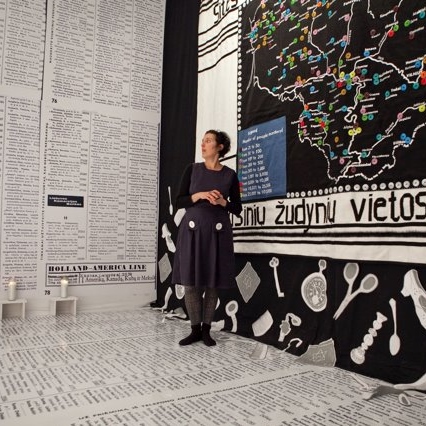
News

A kaddish to Kovno in art
GILLIAN ANSTEY
Almost overwhelmed by her reaction, she joined forces with artist Cheryl Rumbak and composer Philip Miller to create a multimedia installation called “Where is Kovno?”. They presented this at Lithuania’s 2009 textile biennial in Kuanas, the country’s second largest city.
“Where is Kovno?”, which,refers to the Jewish name for Kaunas, was ultimately a Kaddish space to pay respect to the Jews from that area who perished, Walt explains. Prior to the Second World War, there were about 40 000 Jews – a quarter of the population – in Kaunas. Ninety per cent of South African Jews are believed to be descendants of Lithuanians.
The multifaceted installation included a soundscape. Miller recorded sounds in the forests where Jews had been murdered, overlaid with sounds of the Lithuanian University choir learning the Yiddish lullaby Oyfn Propetshik.
Much of the space, including the floor, was papered with a replica of a 1939 Lithuanian phonebook, a physical representation of how many Jewish people had lived there before.
A key focus was a fabric map of Lithuania, bordered by traditional black and white Xhosa blankets, on which Walt and Rumbak had sewn large colourful buttons to indicate the numbers massacred in each site. “Sites of mass murders in Lithuania” is embroidered on the top with the Lithuanian equivalent at the bottom.
That large blanket was one of the main exhibits at the Rabbi Cyril Harris Community Centre at a preview of the “Where is Kovno?” installation last week.
Walt kept referring to this wall hanging as a blanket, which jarred, and therein lies some of its impact. A blanket is warm and comforting and it is eerie to equate this fabric presentation of a sombre subject with something cosy.
Less dramatic but perhaps more engrossing, is a printed map of Lithuania. Each town is shown as a pie-chart, illustrating its proportion of Jews in 1987. It felt exhilarating to report back to relatives that Krok, the village of my paternal grandfather, was north of Kovne, and almost a quarter of its population had been Jewish.
The exhibition is meticulously curated, with all sources identified and the linocuts, created by Walt and Rumbak, all clearly captioned.
The linocuts include some of the 40 former shuls in Kaunas. Most intriguing was the explanation of the telephone and typewriter linocuts. These were objects Walt saw at Sugihara House, from where Japanese Consul-General Chiune Sugihara helped Jews escape by issuing them transit visas to Japan.
“After struggling and agonising,” Sugihara is reported to have said: “I concluded that humanity is paramount. Then, fearing nothing, I decided to issue those visas.”
A year before his death in 1986, Yad Vashem honoured him as a Righteous Among the Nations.
The palpable absence Walt felt, has now been articulated in an artistic form that is fascinating, thought-provoking and, in a strange juxtaposition, aesthetically pleasing.
The exhibition at the Cyril Harris Centre is a taster and fundraiser for the extended one planned for the Johannesburg Holocaust and Genocide Centre in October.
It will feature the Kaddish space plus two additional elements. One is a film of three women’s testimonies about surviving the Lithuanian Holocaust. Another is an audio interview with well-known South African photographer David Goldblatt of his visit to his father’s village, Popolyan.
“David has also allowed us to use his photograph of the forest where the killings happened of that town. So that is an entirely new installation which will be shown for the first time in South Africa,” said Walt.
Lithuania – The Journey Back: A Introduction to the Where is Kovno? project is at the Rabbi Cyril Harris Community Centre in Oaklands until Ma




